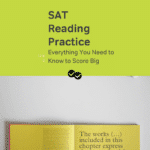On every SAT, there’s one long fiction passage. It’s usually the longest individual reading passage on the test (which means about 75-100 lines). You might get a shorter fiction passage at only 50 or 60 lines long, but that’s less common.
The SAT likes relatively recent fiction, but it’s not unheard of to see something older. There’s a really a wide range of time periods and writing traditions that the story might come from. There are two things you can be sure it won’t be, though: written in totally antiquated English (like Paradise Lost) or taken from a young adult series (like Twilight).
Sometimes you’ll think the story is engaging, which is great. But it’s good to remember that this is the SAT, and that means you’re going to have to answer questions.
So we need to be ready to do that.
Read the italics in the passages
Before every Reading Comprehension passage on the SAT, there are a couple of sentences that tell you where the text is taken from and give you a little bit of background info if necessary. You should always read this, especially when it’s a fiction passage. For one, it tells you it’s fiction in the first place, and that affects what your note-taking strategy will be (more on that in a moment). Besides that, it may give you some important info on the setting and characters.
Even if none of the test questions will actually be about the info in italics, they can be really helpful.
Gradually describe characters
As you read, keep track of which characters you meet. There’ll only be a few—maybe two or three—so this shouldn’t be too tough. But as you read, build up a list of descriptions of those characters. Focus on their personalities and motivations especially; how does the author paint them? Any adjectives you see to describe their personas are worth underlining or circling. It’s good to be thinking about the author’s intentions when you’re doing this. Is the attitude toward a character positive, negative, or neutral?
Distinguish the author’s opinion from characters’ opinions
Every story has a narrator. That story-telling voice might be from a character within the story (the “I”), or it might be that of the author. Think twice about where descriptions of characters are coming from. Do other characters say them, or does the author give you them? How do the characters think of each other?
You want to build up not just an image of each personality but a description of the relationships between them.
Write those character traits in your notes
Those kinds of questions about personalities and relationships are a lot like questions that you’d ask yourself in any other SAT reading passage. The point is to get a solid understanding of the relationships between the things on the paper. When you understand that, you’re in a good position to make inferences, see the big picture, and score points on those trickier questions.
And of course, one of the most useful Critical Reading tips to follow is making sure you read with a pencil in hand.






Leave a Reply